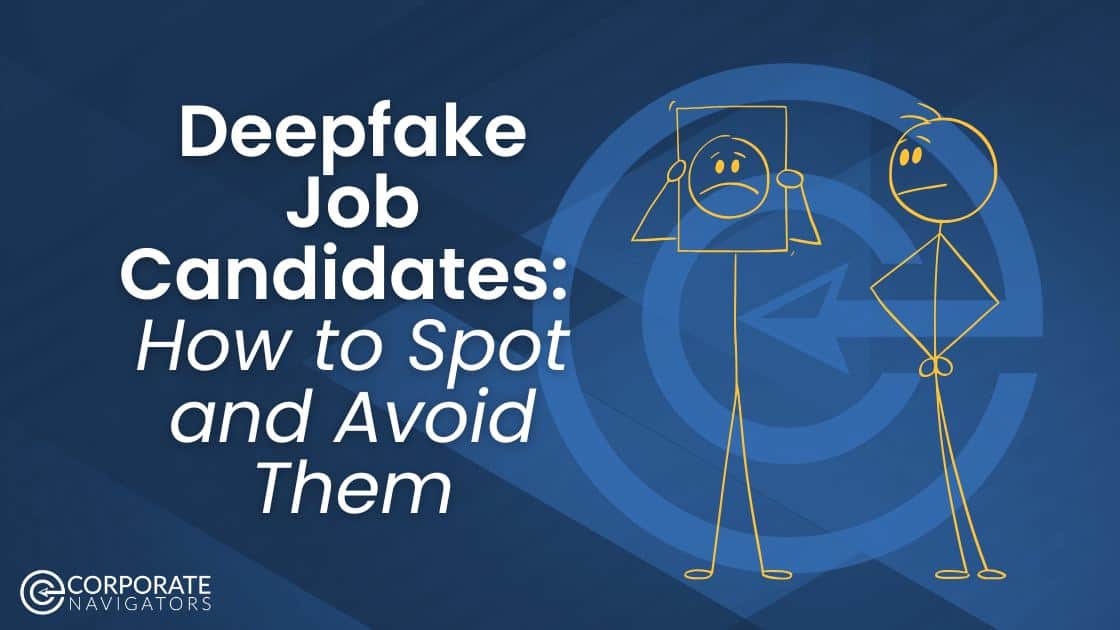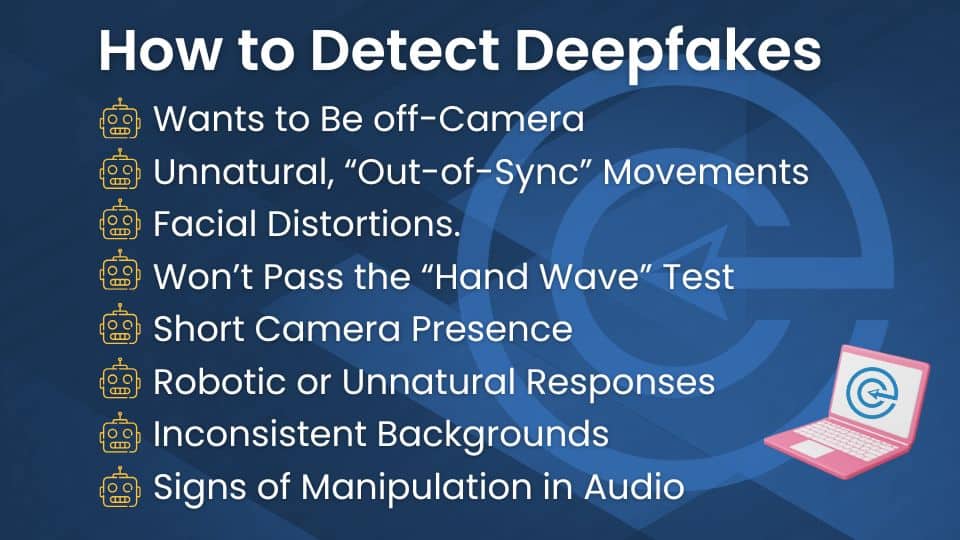
Table of Contents
Fake Job Candidates: A Growing Threat in Recruitment
How easy is it for a company to mistakenly hire a North Korean spy among its sea of job applicants? Well, according to the FBI, easier than you think. Hiring a fake candidate has happened to more than 300 companies, including Fortune 500 ones. With deepfake technology, artificial intelligence, and other deceptive measures like IP Spoofing, fake candidates can pass job interviews when the interviewer isn’t aware of common red flags.
The possibility of onboarding a fake candidate makes deepfake detection measures an imperative for hiring managers, especially ones who plan to hire tech roles remotely. Unfortunately, the rise of deepfake technology has introduced new challenges to the hiring process, particularly in the era of remote work and virtual interviews.
This article explores the prevalence, mechanics, impacts, and detection challenges of deepfake job candidates, providing insights into how organizations can address this emerging issue.
What is Deepfake Technology?
Deepfake technology is an advanced form of artificial intelligence (AI) that creates highly realistic fake images, videos, and audio by manipulating or generating synthetic media. The term “deepfake” combines “deep learning” (a subset of AI) and “fake.” It often involves swapping one person’s likeness with another in existing media or creating entirely fabricated content, such as making someone appear to say or do things they never did.
This is achieved using machine learning techniques like Generative Adversarial Networks (GANs), which refine the realism of the output by iteratively improving the fake content. While deepfakes have legitimate applications in entertainment, gaming, and accessibility tools, they also pose significant risks by enabling the spread of misinformation, identity theft, and fraud.
How similar is a deepfake webcam video to a real person? Well, with technology advancing at a rapid pace, it’s getting harder to tell. However, there are still signs to look out for, which we will get into later in this article. For now, here is an example of how it’s done and what it looks like:
Source: Website Learners
The Prevalence of Deepfake Job Candidates
Deepfake job candidates are becoming a notable concern in recruitment. While resume fraud is common—77.6% of recruiters report encountering misrepresentation during hiring—deepfakes represent a more sophisticated form of deception.
The FBI has warned about fraudulent candidates using deepfake technology during remote interviews, highlighting the increasing frequency of such incidents. Reports suggest that a deepfake fraud attempt occurs every five minutes globally, underscoring the urgency of addressing this issue.
Spotting and avoiding deepfake job candidates is crucial to maintaining the integrity of recruitment processes and safeguarding organizational security. Deepfakes enable fraudsters to impersonate individuals, fabricate credentials, and manipulate virtual interviews with hyper-realistic AI-generated video and audio.
What Happens when Deepfake Candidates Go Undetected?
If undetected, these fraudulent hires can lead to severe consequences, including unqualified individuals occupying critical roles, exposure to cyberattacks, theft of sensitive data, and reputation damage. In extreme cases, deepfake operatives have infiltrated companies to deploy malware or extract intellectual property.
Additionally, reliance on traditional verification methods like video interviews or reference checks is no longer sufficient against sophisticated AI manipulations. By implementing robust detection technologies, enhancing verification protocols, and training HR teams to recognize signs of deepfake fraud, organizations can protect themselves from these risks while ensuring their hiring processes remain secure and trustworthy.
How Deepfake Job Scams Work
Deepfake job scams typically involve these aspects:
- Identity Theft: Scammers collect personal information through fake job postings to craft convincing resumes.
- AI Manipulation: Using publicly available tools, they create fake personas by cloning voices and overlaying faces onto live video feeds.
- Execution: These fraudulent candidates participate in virtual interviews, impersonating qualified professionals or even stealing identities to bypass background checks.
This enables unqualified individuals to secure roles or infiltrate organizations for malicious purposes.
Impact on Recruitment
False candidates on webcams can pose significant risks to businesses which include the following:
- Hiring Unqualified Candidates: Organizations may unknowingly hire individuals who lack the required skills or credentials.
- Security Threats: Fraudulent hires can lead to cyberattacks or data breaches, especially in sensitive industries like IT, finance, and cybersecurity.
- Financial Losses: Costs associated with rectifying mistakes from fraudulent hires can be substantial. For instance, cybercrime linked to remote work caused over $46 million in losses in 2020.
Industries reliant on remote work are particularly vulnerable due to the increased use of virtual interviews.

Challenges in Detection
Detecting deepfake candidates is increasingly difficult as technology advances. Deepfake videos and real-time streaming can attempt to mask the user’s real face, with the “red flags” only becoming more subtle. Signs like unnatural eye movements, audio-lip sync issues, or robotic responses during interviews may hint at deepfakes but are not always obvious.
As technology becomes more sophisticated, Deepfake tech is becoming harder to identify without specialized tools. Therefore, organizations must invest in advanced detection methods and train HR teams to recognize potential scams effectively.
How to Detect Deepfakes
Worried about getting tricked by a deepfake candidate? We understand. Thankfully there are methods where you can spot a deepfake which other interviewers have used successfully to cut loose a scammer, ending the interview before any damage was done.
1. “My Camera’s Not Working”
Sure, it isn’t. 🙄 Just like some fast food joints may fib that the ice cream machine “isn’t working,” scammers will do anything to not appear face-to-face. They will prefer to be off-camera for a video call, even lying to say that their camera is broken. This is highly suspicious for job seekers who claim to work remotely and would routinely need to use cameras during meetings.
2. Unnatural, “Out-of-Sync” Movements
You may observe for unnatural eye and mouth movements that appear out of sync with speech. Also, pay attention to facial expressions or movements that seem robotic or lack natural fluidity, as these are common signs of deepfake technology.
3. Sus Facial Distortions
If it looks weird, just trust your gut. Look for distorted edges around the face, which may resemble the effect of a face-swapping filter. Look for irregularities or distortions around the edges of the face, which may resemble effects from face-swapping filters.
4. The Candidate Won’t Pass the “Hand Wave” Test
Deepfake images will be disrupted if objects pass in front of their projected “face”. So, a sure way to rule out a deepfake is to ask the candidate to wave their hand in front of their face. This action will disrupt deepfake filters, exposing fraudulent candidates (who may abruptly leave the call).
5. A “Short” Camera Presence
Deepfake candidates often stay on camera briefly, avoiding prolonged exposure that might reveal inconsistencies. For, as you know, the longer you look at something, the easier it is to tell that something’s not right.
6. Robotic or Unnatural Responses
Pay attention to speech patterns or body movements that seem overly mechanical or unnatural. If you go on youtube and look at deepfake examples, you can start to get used to what those nuances are.
7. Inconsistent or Manipulated Backgrounds
Are they in Costa Rica one moment, then in the Library of Congress in another meeting? Hmm, that seems suspicious. Check for mismatched or manipulated backgrounds that may indicate tampering as well, which indicates they are not really where they say they are.
8. Signs of Manipulation in Audio
Catfishing also applies to voice! Listen for unnatural vocal patterns, mismatched lip-syncing, or audio distortions indicative of synthetic generation. This can indicate that the person behind the filter is not who they say they are. They may even be a different gender, age, etc.
By staying vigilant and using these observations, recruiters can better detect potential deepfake fraud during the hiring process.
Addressing the Threat
To combat deepfake job candidates, companies can also take on these extra precautions:
Adopt AI Detection Tools: Use software capable of identifying manipulated video or audio during interviews.
Verify Credentials Thoroughly: Implement robust background checks and cross-reference candidate information with trusted sources. Hiring a recruiting research and candidate sourcing firm like Corporate Navigators can ensure you get a list of candidates with verified identities and qualification.
Educate Recruiters: Train HR personnel to spot signs of deepfakes and understand the risks associated with virtual hiring.
Additionally, collaboration with cybersecurity experts can help safeguard recruitment processes against emerging threats.
Identifying Deepfake Candidates
Deepfake job candidates represent a growing challenge for modern recruitment. As remote work becomes more prevalent, organizations must remain vigilant and proactive in addressing this sophisticated form of fraud.
By leveraging advanced technologies and enhancing their recruitment practices, businesses can protect themselves from the risks posed by deepfakes while ensuring the integrity of their hiring processes.


